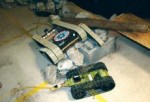Robotics institute slated for USF

When the Crandall Canyon mine collapsed in Utah last year, Robin Murphy and her robots were there to help rescue workers attempt to save the trapped miners. While there, Murphy, the director of the Center for Robot Assisted Search and Rescue (CRASAR) and a professor of computer sciences and engineering at USF, received a number of calls from people who had built or designed a robot and wanted to help the rescue attempt. The problem, Murphy said, was that her team had no way of knowing which, if any, of those designs would work in a real-life rescue situation like the Crandall Canyon collapse.
Soon, Murphy and her colleagues will have a way to field test robots before bringing them to the scene of a disaster.
In December 2008, USF will finish building the National Testbed for Safety, Security, and Rescue Technologies, which will be located on the northwest corner of the Tampa campus.
It will be a three-story, reconfigurable facility designed to provide lifelike simulations of collapsed buildings or mines, or other disasters that would require the use of remote-controlled robots. The facility will have the ability to add smoke, chemical and biological elements to each configuration.
This lifelike simulation is getting the attention of researchers in the area. Dennis Killinger, professor of physics at USF, has been working with Murphy on developing optical sensors for the robots.
“What we have been looking at is advanced types of imaging cameras and sensors, to be used inside of mines and collapsed buildings to be able to see people and objects,” he said.
Killinger has been working on near-infrared light waves, which are able to pierce through clouds of smoke and debris and allow the robot operator to get a clear view of where the robot is and what is around it.
He has also been working with laser sensing of the atmosphere and liquids, which would allow rescue workers to detect explosives or other elements hazardous to humans. Killinger said his work is focused on finding the optimal wavelengths for these sensors. Once this work is ready to be field tested, the new facility will be ready to challenge his work with a variety of elements that hamper the effectiveness of conventional cameras.
The robots being developed at CRASAR are meant to have multiple functions so they can perform whatever task rescue workers need. They are able to test for structural weaknesses in collapsed buildings, detect hazardous materials, perform search and rescue missions or deliver medical supplies to victims trapped under rubble.
Murphy said the robots being designed at CRASAR are not being used to replace humans; they’re designed to go into places and perform tasks that humans can’t.
The new testing facility should bring other advantages to the University, she said, besides the obvious benefits from the simulation. She said because there aren’t any universities with facilities like this, it will make the testbed the first in the region for certifying robots for search and rescue or bomb squad use.
Murphy made comparisons between USF’s robotics program now and the early days of aerodynamics research when institutions like the University of Michigan began constructing wind tunnels. Those institutions quickly developed close relationships with companies interested in the latest research, bringing both financial benefits and national notoriety. “We look at that as a huge economic driver,” she said, “and that’s going to give us pairings with companies like … Hewlett Packard and Stanford. Modestly, that’s what we’re trying to do here.”





